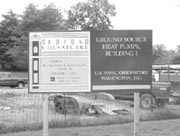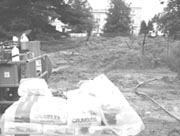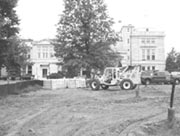
The 108-year-old US Naval Observatory was built in 1893 at Observatory Circle on Massachusetts Avenue next to the Vice President's residence. Land that encircles the observatory protects and guards delicate astronomical instruments against smoke and heated air and absorbs vibrations from traffic of public thoroughfares.
Equally important is a reliable heating and cooling system to protect sensitive nautical charts and air almanacs stored in vaults. Despite progress and invention of more advanced navigation techniques, celestial navigation via chronometer and sextant is still an important secondary method of navigation because it cannot be jammed.
The geothermal well field consists of 50 boreholes, six-inches in diameter and 405 feet deep; each borehole has two one-inch loops. The soil encountered was 63-80 feet of saprolite overburden underlain by bedrock of the Potomac group, and the water table was 40 feet below ground surface. Boreholes were drilled and grouted by Mike Barlow of Thermal Loop Corporation and Geothermal Company of Joppa, MD.
Barlow selected a two-step bentonite grout manufactured by CETCO Drilling Products. This two-step grouting system offers a uniform grout from top to bottom of the borehole. The grout is referred to as two-step because Insta-Pac liquid polymer is added separate from Volclay Crumbles granular bentonite. This Insta-Pac/Crumbles bentonite grout blends a granular bentonite with a quick activating liquid polymer to form a slurry that provides a basic economical way to seal boreholes. Once set, this bentonite slurry forms a thick complete grout seal with low permeability.

The mixing procedure for the grout is to add eight oz. liquid polymer to each 33-gallons of fresh water and mix within the tub of the paddle mixer. Next quickly add one 50 lb. bag of Volclay Crumbles to the water slurry while mixing gently. Start pumping when the Volclay Crumbles have been completely dispensed into the water/polymer mixture. After the batch is pumped, flush pump hoses and tremie pipe with fresh water.
Swelling of granular bentonite (Volclay Crumbles), is delayed by liquid polymer (Insta-Pac), long enough to deliver the bentonite down hole to expand Insitu. The end product is a sturdy grout that bonds to casing and formation with a density of 9.3 lb/gal, yielding 4.01 ft3. The thermal conductivity is 0.45 BTU/hourFt°F and the permeability is 1.0 x 10-8 cm/sec.

The geothermal heating and cooling system was designed at 100 tons total, or two tons per borehole, consisting of five circuits with ten wells on each circuit. Two duplex recirculating pumps - each with a manifold and balancing tank to maintain pressure - are housed in the basement of the observatory. This geothermal system provides comfortable heating and cooling at an estimated 40% less cost than the conventional heating and cooling system previously installed.

Report Abusive Comment